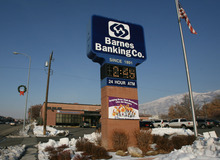This is an archived article that was published on sltrib.com in 2012, and information in the article may be outdated. It is provided only for personal research purposes and may not be reprinted.
A shareholder of the company that owned Barnes Banking Co. when it collapsed two years ago has sued numerous directors and officers, accusing them of nepotism and encouraging risky lending practices that ultimately destroyed the financial institution.
The lawsuit filed in 3rd District Court last month might start a new chapter in the ongoing troubles faced by Utah community banks during and after the financial crisis. Since 2009, five banks have failed because of their overexposure to construction and land-development loans that turned bad when the real estate bubble burst and the U.S. recession began. Until now, shareholders apparently haven't attempted to hold officers and directors of the banks — America West, Barnes, Centennial, MagnetBank and SunFirst — legally accountable for the failures.
It isn't clear how much money shareholders of the five banks have collectively lost from the failures. Only the Barnes suit attempts to quantify that. It suggests shareholders saw $130 million vanish. But even as they were coming to grips with their combined losses, the Federal Deposit Insurance Corp.'s insurance fund that protects bank deposits in the event of a collapse paid out $656 million to consumers, including $271 million to Barnes customers, since the first bank failed in 2009.
Starting in 2005, former Barnes Bancorp CEO Curtis Harris and seven other defendants abandoned a century of conservative lending to farmers and small businesses primarily in Davis County in order to cash in on consumer demand for high-risk real estate loans in hot housing markets elsewhere in the state, shareholder J. Canute Barnes alleged in his suit.
The defendants allegedly compounded the bank's exposure to risky loans by appointing inexperienced and incompetent managers, including family members, to head up Barnes offices where large numbers of commercial real estate and land development loans were being made, according to the suit. Real estate loans that weren't repaid when the housing bubble burst were a key reason why Utah regulators seized the insolvent bank in January 2010.
Canute Barnes, a retired physician who lives in Seattle, said Wednesday he would not discuss the suit until a later time. He is the son of Herbert Barnes, a former director of the bank.
Harris, Chairman Michael Pavich and Gary Wright, the current CEO of Barnes Bancorp, could not be reached for comment. Former Chairman Ned Giles; directors David Barnes and Robert Thurgood; and former chief financial officer Douglas Stanger did not respond to requests for comment.
Jerry Stevenson, a director and Utah legislator, said the lawsuit was "unfounded" but would not elaborate. He was countered by Thomas Karrenberg, an attorney at one of two Salt Lake City firms representing Canute Barnes, who said "we disagree with Mr. Stevenson. The complaint sets forth the allegations and even includes information from the [Federal Deposit Insurance Corp.] and the Federal Reserve about the conduct complained of."
Canute Barnes filed the suit on behalf of "all similarly situated" shareholders, alleging that the defendants "destroyed" Barnes Bancorp by permitting the bank to make real estate loans with unsafe loan-to-value ratios and based on "stale" appraisals. The suit said Barnes Bancorp also allowed so-called liar loans to borrowers who supplied "improper" or "incomplete" financial disclosures in their applications.
The suit alleges that the defendants allowed the bank to make large numbers of land-development and construction loans in St. George, where James Harris, the son of Curtis Harris, managed a Barnes branch office.
John Barnes, the son of director David Barnes, was appointed manager of the bank's Fort Union branch in Midvale. John Barnes, like James Harris, were two of three bank officers singled out in the suit as lacking "the competence and experience to manage the bank's branches ... particularly ... those branches that were investing heavily in risky CRE [commercial real estate] and ADC [real estate acquisition, development and construction] loans, which were a leading cause of the bank's demise."
John Barnes and James Harris could not be reached for comment.
Twitter: @saltlakepaul



